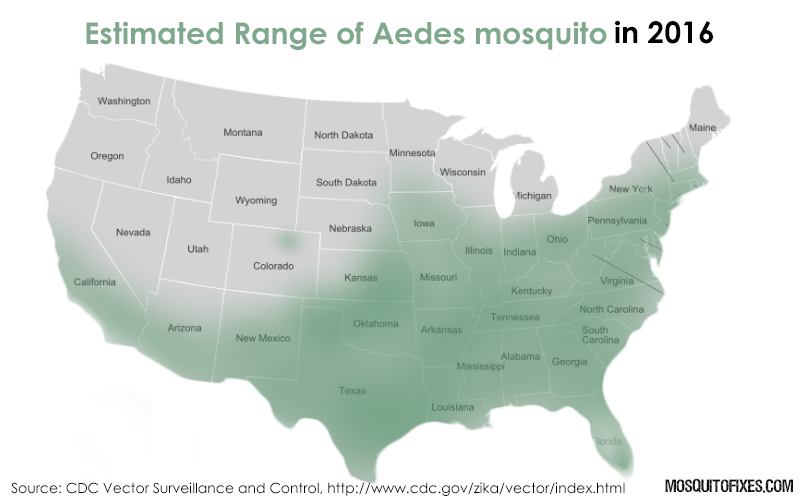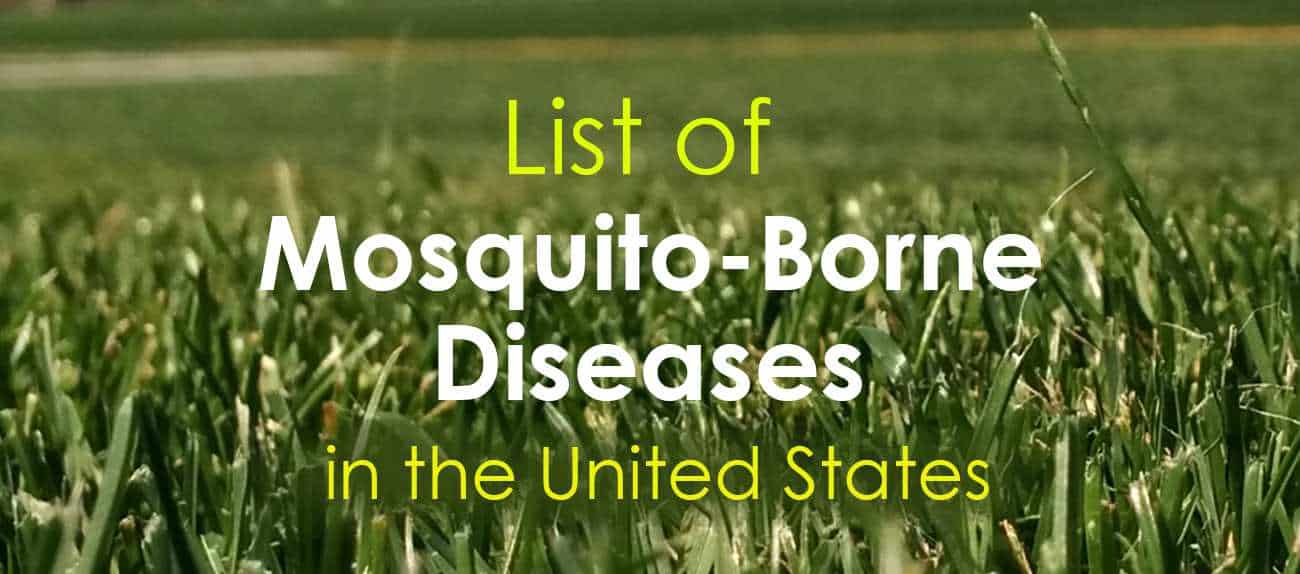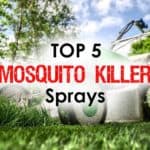Mosquitoes carry a lot of harmful diseases. This article aims to give you a short overview about the most frequent viruses and provides additional resources and links.
While it is useful to know about different diseases and their symptoms you should always consult a local healthcare provider. This is not a medical advice.
Zika
This virus was first discovered in 1947. Ever since it has spread around Africa, Asia and recently South America. There have been cases in US territories already (Puerto Rico, the US Virgin Islands, and American Samoa) and it will likely reach US mainland soon.
Although Zika can be transmitted via sexual intercourse, an infection is far more likely through the bite of Aedes mosquitoes. Consequently, mosquito control plays an important role in the fight against the virus. Most infected people suffer from mild symptoms like fever, joint pain and red eyes. Many victims who carry the virus don’t even realize it. The signs usually go away after several days or remain undiscovered.

However, Zika virus has been reported to cause birth defects in newborn babies. It increases the risk of microcephaly, a disorder which hinders the brain from developing properly. Furthermore it can lead to Guillain-Barré syndrome, an autoimmune disease that weakens the muscles. As a result, pregnant women should avoid visiting infected areas.
What you can do:
In 2016, the WHO has declared Zika a Public Health Emergency of International Concern. Scientists try to come up with a vaccine but so far the only way to avoid Zika is to minimize the risk of getting bitten. Stay out of mosquito vectors and try to control your local Aedes population. It’s advisable to stay up-to-date with the newest developments regarding Zika.
Zika Resources:
CDC Travel Information Trips you should avoid
Fact Sheet by the California Department of Public Health
Zika regions Areas where Zika is spreading
Microcephaly key facts by the WHO
Zika News by the WHO
West Nile Virus
Since it has been discovered in Uganda in 1937, ongoing outbreaks have emerged in all 5 continents. Most people infected with WNV don’t develop any signs, but a minority can experience mild symptoms like fever, headache or fatigue. They usually resolve on their own after a short amount of time.
In less than 1% of the infections West Nile Virus causes severe neurological complications. They lead to an inflammation of the brain (encephalitis) and the areas around the spinal cord (meningitis). During the worst epidemic in 2012, almost 300 people in the US died.
The major factor of transmission are mosquito species, primarily the Culex-types. These mosquitoes feed on birds and other mammals which can die after an infection. As a result, any dead birds can indicate WVN outbreaks and should be reported.
What you can do:
There is no vaccine available, so the only way to minimize the risk is through prevention and mosquito control. In addition, you should report dead birds to your local authorities. If you need further information check out the links below.
WNV Resources
Detailed Map of Human WNV Cases
WNV Information by the CDC
Helpful List by the National Pesticide Information Center
Viruses that cause Encephalitis
There is a number of different diseases that cause inflammation of the brain. The most common types are:
- Louis Encephalitis (SLE)
- Eastern Equine Encephalitis (EEE)
- LaCrosse Encephalitis (LAC)
- Western Equine Encephalitis (WEE)
- Eastern Equine Encephalitis (EEE)
All of these diseases are transmitted by mosquitoes and usually affect humans, horses and birds. Although infections are rare they sometimes result in serious complications and death. If you want further information you can take a look at the website of the American Mosquito Control Association.
What you can do:
There is currently no vaccine for humans against any of the diseases above. Vaccines for horses are available and should be considered if you own such animals. Apart from that the most effective way to protect yourself is mosquito bite prevention.
Dog Heartworm (Dirofilaria immitis)
This is not a virus but a small worm which gets transmitted by mosquitoes. Dogs are the primary hosts, hence the name. Under rare circumstances it can also infect other mammals like cats, wolves and humans.
Animals have a significantly higher risk of an infection than humans. As a result, most heartworm prevention revolves around protecting dogs from the disease. This also limits the chance of a transmission to humans.
What you can do:
If you own a dog it should be tested annually during a routine visit at the vet. There’s a treatment available that can get rid of heartworms within 6 months.
Heartworm Resources
Information regarding pets – by the American Heartworm Society
Symptoms in Dogs – PetMD
Heartworm information – by the University of Florida
A worm’s life cycle – graphic on Wikipedia
Travel-Related Diseases

The following diseases are usually transmitted during visits to other countries. The chance of a transmission is very small in the US. However, in rare cases an infected person can spread the disease upon contact.
Malaria
About 1,500 cases occur every year in the US. Most of them are travelers or immigrants who visited high-risk countries where outbreaks happened. The parasite is carried by the Anopheles mosquito which spreads the disease from person to person.
Symptoms include fever, headache and flu-like illness. In case of an infection it’s important to contact a healthcare provider because malaria can become life-threatening. Consequently, it’s best to prevent the disease before a transmission happens.
What you can do:
Avoid visiting mosquito vectors whenever you can. If that’s not possible, bite prevention while travelling diminishes the risk of a transmission.
There are effective antimalarial drugs available that can protect you from getting the disease. However it’s important to give yourself enough time to prepare everything. It’s best to visit your local healthcare provider 6 weeks before your trip starts.
Furthermore you should also check out the resources below because they give you an overview about the risks and places where outbreaks happen.
Malaria Resources
Useful information about malaria – CDC
Map of high-risk areas – CDC
Malaria factsheet – by the WHO
Dengue
Dengue fever is the fastest-growing mosquito-borne disease in the world and can result in severe complications. ‘Normal’ dengue fever usually comes with mild fever, nausea and other symptoms like headache. However, in some cases it can evolve into severe dengue, which can lead to leaking blood vessels and death.
What you can do:
There is no specific treatment or vaccine available so the only way to prevent the virus is to minimize exposure to mosquito bites.
Dengue Resources
Travel information and more – CDC
Map of infected areas – Healthmap
Health information on Dengue – Medline Plus
Dengue info hub – WHO
Chikungunya
Another viral disease carried by Aedes mosquitoes that can result in fever, headache and long-lasting joint pain. In very rare cases Chikungunya can become more severe. There were outbreaks with millions of infections in the Caribbean, India, Southeast Asian and Europe.
Most of the cases in the US are travel-related. However, in 2014 local transmissions happened for the first time in Florida. There is no established way to diagnose and treat the disease, it may vary from case to case.
What you can do:
There is no vaccine available so the only way to avoid the disease is to prevent mosquito bites with mosquito control and other barriers like nets or repellents.
Chikungunya Resources
Map of risky areas – CDC
Factsheet – WHO
A lot of information regarding Chikungunya – PAHO
Yellow Fever
A viral disease found in South America and Africa that leads to mild illness. Very rarely it can result in more severe liver bleedings. Yellow fever is transmitted by Aedes or Haemagogus mosquitoes and can infect primates as well as humans.
The virus is widespread in many countries and some may even require proof of vaccination before you can enter them.
What you can do:
There is an (expensive) vaccine available that can prevent yellow fever. Consult your local health care provider for more information. Additionally it’s always advisable to limit exposure to mosquito bites and protect yourself with clothes and repellents.
Yellow Fever Resources
General information – CDC
Yellow Fever factsheet – WHO
Yellow Fever symptoms – WebMD
Yellow Fever Vaccine – CDC
Mosquito-Borne Diseases
As you can see, there are many different risks related to mosquito bites. Due to numerous types of symptoms it’s not always easy to spot an illness caused by mosquitoes. Therefore it’s recommendable to contact a local healthcare provider and ask for help.
To prevent mosquito-borne diseases you can try to minimize the risk of bites. Mosquito control helps to diminish the number of mosquitoes. Protective clothes and repellents can create a barrier between you and harmful animals.
You can also rely on different strategies to prevent mosquito bites while travelling abroad. Nothing guarantees 100% protection, but they can significantly reduce your risk. In addition it’s best to stay up-to-date with the newest developments regarding mosquito borne diseases:
Helpful Websites and Resources
- List of diseases by the National Pesticide Information Center
- Website of the American Mosquito Control Association
- WHO-website about insect-borne diseases
- List of mosquito-borne diseases on Wikipedia
- CDC Division of Vector-Borne Diseases
Hi! My name is Mark and I’m an outdoor freak.
Visiting many exotic places around the world allowed me to gain some knowledge about effective mosquito control. That’s why I decided to start this site and give you in-depth reviews regarding the best repellents and traps.
And yes, you may call me Mosquito Mark.







